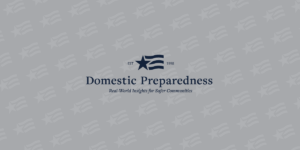

Editor’s Message: 6-Month Review – June 2022
Catherine L. Feinman
June 29, 2022
The first half of 2022 certainly has been busy! As businesses fully reopen and people around the world begin to explore life in the new normal, the Domestic Preparedness Journal has been exploring its new normal as well. The journal was launched in 1998 to bridge the communication and collaboration gaps between disciplines and across jurisdictions. While the journal has now been entrusted to a new steward, the mission of bridging gaps across disciplines and jurisdictions remains the same.

Building Capability: Zero Tolerance vs. Acceptability
Christopher Tantlinger
June 22, 2022
A tool designed with zero tolerance would not be able to function efficiently or effectively.
Likewise, taking a zero-tolerance approach to emergency preparedness and response has led to some
problematic policies and procedures. This article explains why building in some level of acceptability
would make policies and procedures more effective and communities more resilient.

Working Together: Partnership, Training, Funding & Tolerance
Catherine L. Feinman
June 22, 2022
When community stakeholders work together to prepare for emergencies and disasters, they will be
better prepared and have more resources to face whatever threats, risks, and hazards are in their
future. Four key aspects to consider when building community resilience are addressed in this June
edition of the Domestic Preparedness Journal: public-private partnerships, training, funding, and
tolerance.

How The Best Get Better: Partnerships & A Trifecta Disaster
Judy Kruger and Scott Harris
June 21, 2022
Japan is more prepared for future disasters due to communications and annual investments into exercises and drills with local and international partners. Tokyo Disney Resort leveraged private-public partnerships to increase preparedness in employees, guests, business services, critical infrastructure facilities, and government stakeholders to manage future disruptions caused by natural disasters. A private-public partnership helped align business needs and supported risk-information decision-making during a complex, large-scale disaster.

Public Safety Grant Programs Changes – A 10-Year Review
Kurt Bradley
June 15, 2022
Article Out Loud Change is inevitable. As society continues to progress in the “digital age,” so has applying for various federal grant programs. It is becoming almost impossible to apply

The Risk-Based Approach to Hazardous Material/WMD Incidents
Tony Mussorfiti
June 8, 2022
Low-frequency, high-consequence events are rare, emergency responders still need to be able to evaluate these complex problems and determine initial actions. To avoid being overwhelmed and increasing the risks to both responders and civilians, emergency responders need to be able to quickly identify all potential hazards, then predict the outcome when a hazardous material or weapon of mass destruction¬ (WMD) incident occurs. This article explains how a risk-based approach will better prepare responders for future situations.

